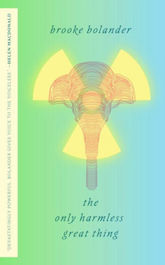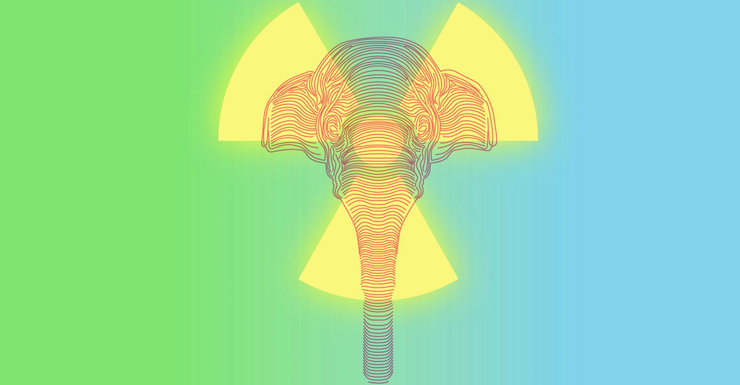I’ve been hearing about Brooke Bolander’s The Only Harmless Great Thing for a while. Often with superlative adjectives attached, usually from people whose taste I trust. It’s hard to believe this much advance hype, so I approached the novella with an attitude of dubious caution, much as one might approach a strange cat that one would dearly like to pet.
Especially since I’d also heard it was both angry and tragic.
Well. Well.
Well.
Buy the Book


The Only Harmless Great Thing
Bolander’s got form for angry and sideways-on to tragic, perhaps most notably in the very short “Our Talons Can Crush Galaxies,” nominated for multiple awards. The Only Harmless Great Thing is something else again. This is a gloriously angry novella, a bitter, biting, furious indictment of capitalism, power, and the legacy of wrongs carried forward into the future. It’s also an elegantly beautiful fist to the face, an ode to power and memory and not just lying down to die—even if death itself is inevitable. It’s powerful and elegiac and if one part of its ending is inevitable, it doesn’t feel tragic. It feels, instead, as if The Only Harmless Great Thing is leaving us with a deliberately unanswered question, counterpoint to the (equally unanswered) question implied in the title: What do we do with what’s done to us, and with the legacy of wrongs handed down to us—for whose commission we were not responsible, but whose consequences we bear with us?
And what great thing is ever truly harmless?
The Only Harmless Great Thing takes place in a world where elephants are sentient, and known to have always been so, and are possessed of language—at least, the ability to use sign language to communicate with humans. The elephants of The Only Harmless Great Thing also appear to possess something akin to a shared species memory, a collective memory of Many Mothers. Otherwise, the world is our own, cast in unforgiving relief.
There are four narrative veins running through The Only Harmless Great Thing, deep and strong as blood. One takes place in mythic time: it is a folkloric narrative about an elephant foremother, who brings to the females of the elephant species the awareness of stories, and connection to each other, but only at great cost. Two, closely linked, take place in an American factory in the early 1940s: US Radium. Here, Regan, a factory girl dying of the physical degeneration brought on by exposure to and ingestion of radium’s radioactive poison, is spending the last weeks of her life desperately waiting for her compensation cheque and teaching the enslaved elephant known as Topsy how to work with the poison that will eventually kill Topsy as surely as it has made Regan a dead woman walking. Regan and Topsy’s lives intertwine here, though Topsy’s narrative is told in an entirely different register than Regan’s rich colloquial dialect.
And later, in some unspecified modern period, a scientist called Kat comes up with an idea to make sure warnings for nuclear waste survive the ages: make elephants glow, and deed them the land. Kat’s well-intentioned stereotyping—elephants are associated with radioactivity—brings her face-to-face with the ways that people in power have failed the people they held power over, and with history’s misrememberings.
This is an angry novella and a vital one: powerful and fierce, filled with empathy, and utterly unwilling to pull any of its punches.
Despite its accomplishments as a work of art, however, The Only Harmless Great Thing falls down in linking its separate narrative strands together. It doesn’t quite succeed in integrating the folktale element into the plainer text, nor in connecting both folktale and 1940s strands strongly to Kat’s unspecified modernity. Bolander leans heavily on dream logic, on the logic of symbols drifting into patterns with each other, but the story suffers from failing to sharpen the symbols into the needles that would stitch the separate layers together, and from failing to draw the dream logic into a sturdy thread.
The Only Harmless Great Thing had the potential to be more than the sum of its parts. But, in the end, it doesn’t achieve the impact that it could, had it come together a little more strongly. It’s underwritten, and nowhere is this more obvious than its ending, which doesn’t conclude as much as stop.
It’s still pretty excellent. Bolander has talent, and more than that, skill. The Only Harmless Great Thing demonstrates her potential to become one of the truly great prose voices of her generation. I look forward to seeing her hone her craft in years to come.
And about that ending. Don’t look away. The Only Harmless Great Thing won’t let you—
—and while the view may hurt, it’s worth it.
The Only Harmless Great Thing is available from Tor.com Publishing.
Read an excerpt here.
Liz Bourke is a cranky queer person who reads books. She holds a Ph.D in Classics from Trinity College, Dublin. Her first book, Sleeping With Monsters, a collection of reviews and criticism, is out now from Aqueduct Press. Find her at her blog, where she’s been known to talk about even more books thanks to her Patreon supporters. Or find her at her Twitter. She supports the work of the Irish Refugee Council and the Abortion Rights Campaign.










